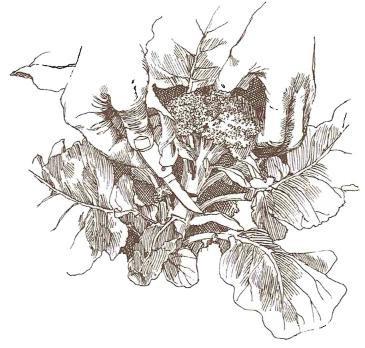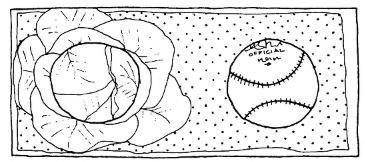 You can enjoy a rich harvest of cabbage, broccoli, cauliflower and Brussels sprouts -- if you use your head at harvest time.
You can enjoy a rich harvest of cabbage, broccoli, cauliflower and Brussels sprouts -- if you use your head at harvest time.
Broccoli is like a trick candle you can't blow out. Once you pick the first head, the plant responds by producing more side shoots for you to eat. The first head is prime for cutting when its buds are packed close together without any sign of blossoming. Cut it off then, even if the head is smaller than you'd like. If you wait until the small yellow flower blossoms appear, the head will become bitter and the plant won't produce side shoots; it's already gone to seed (bolted). If you spot any yellow blossoms, cut the broccoli. You may stop the bolting process in time, and side shoots may form.
Leave 2 to 3 inches of stem on the plant; the second, lateral heads will branch out from there. Harvest these smaller spears on a daily basis, breaking or cutting them off the plant close to the main stem. Most of the broccoli stem is tender enough to eat, although the most tender part is at the top, nearest the newest growth. Again, if you harvest before these side shoots blossom, you should be able to keep the plant producing for weeks!
Brussels sprouts are easy to harvest. Starting when they're marble-sized, pick off sprouts from the bottom of the plant, moving up the stalk as you go. Also pick off any loose or soft buds, even if you aren't going to eat them, so the plant will keep producing new sprouts.
In the far North, you may be able to harvest Brussels sprouts into December or January, brushing aside snow to reach the plants. In more temperate climates, these extra-hardy plants will produce throughout the winter months.
Cutting CabbageCabbage can be a challenge at midsummer harvest time because you can coax each plant into producing two, three or up to six heads for a fall harvest. To do it, you must harvest the first spring-planted cabbage when the heads are fairly small, about softball size. These small heads make terrific coleslaw for two. Leave four to five lower leaves on the plant, and from each leaf or two another small head may appear.
Of course, you can settle for just one cabbage from each plant. You have no choice in the fall, because your second crop of cabbage only has time to make single heads. Harvest the largest heads in the row; the larger and firmer they are, the better they'll keep.
Harvesting Cauliflower and FriendsCauliflower heads are ready to harvest as soon as they are blanched pure white and have grown to be 6 to 12 inches across. Each plant produces only one head, so make the most of your growing efforts and keep harvesting any heads that are ready. Simply cut off the head, leaving about 3 inches of stem to keep the florets intact.
Chinese cabbage is best harvested fully grown, although the leaves are edible right from the start. When the loose heads are 12 to 15 inches tall, cut them off at the base with a sharp knife. Harvest the largest heads first to make room for the rest to develop.
Kohlrabi should be pulled when it's 2 to 3 inches across. Don't let it grow any bigger or the bulb will become tough, bitter and woody tasting.

Although all of the cole crops are easy to freeze, cabbages will also keep in a root cellar or other winter storage facility.
To store cabbages, harvest only fully mature heads, handling them carefully to prevent bruising. Don't wash the heads or trim off any outer leaves; these will help protect the heads.
Cabbages can be tricky to store for extended periods. They need cool, moist, dark surroundings, such as a root cellar with an even temperature. To prolong preservation, wrap each head in several thicknesses of newspaper. Check your stored cabbages often -- even slight rot can send out a three-alarm smell.
If you don't have a root cellar, you can make cabbage storage mounds outdoors with very little effort. Dig a deep hole, and line the bottom with a heavy layer of straw for insulation. Place the heads upside-down in the hole, cover them with more thick straw, shovel 4 to 5 inches of soil around the straw and leave an opening on top. Cover the opening with a board. Whenever you need a cabbage, dig down into the straw pit and repack the straw around the remaining vegetables when you're finished.

 Victory Seed Company has all the seeds you want for your best garden in 2024.
Victory Seed Company has all the seeds you want for your best garden in 2024.
For 25 years, the family-owned Victory Seed Company has provided the highest quality vegetable, herb and flower seeds to families across the country. We are passionate about providing you the best seeds available that give excellent germination, robust plants, and the harvest you want. With a catalog of over a thousand varieties, we have everything, and our prices are the kinds that we'd want to pay. We have hundreds of yesterday's heirloom vegetables, as well as today's award winning hybrid selections. Get to know us by visiting our website and browsing through our online vegetable seed catalog.
| 1. It's Harvest Time ← you're on this article right now |
| 1. It's Harvest Time ← you're on this article right now |